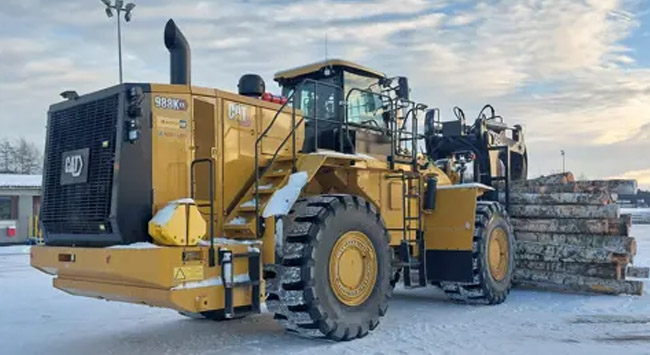Wednesday, January 24, 2024
|
Listen to this news
|

UPM Plywood heads towards its sustainable goals with the use of biofuels-powered log yard machinery. The company has reduced greenhouse gas emissions in its log handling operations by 70 percent by using lightweight and energy-efficient machinery powered by biofuels. This particular initiative is one among many that reduce the carbon footprint of the WISA plywood value chain.
To find potential emission reductions, UPM Plywood is continuously scrutinising every link of its value chain. The recent initiative to reduce the indirect emissions caused by UPM Plywood but generated elsewhere – known as scope 3 emissions – focuses on the work of the subcontractor at the log yard. The machinery used to transport, sort and prepare wood for the UPM plywood mills in Pellos and Savonlinna in Finland now runs on renewable diesel instead of fossil-based fuels.
This particular idea to chamge to biofuels occured to Director for Wood Procurement at UPM Plywood Juha Korhonen when it was time to negotiate a new subcontractor deal for the UPM Savonlinna plywood mill a few years back.
“We required that the bids included a renewal of the machine fleet and a shift to fossil-free fuels. After going through the offers, we chose the most competitive and credible deal,” explains Korhonen, a seasoned woodsman with nearly 40 years of experience in the forestry business.
The same criteria will adhere to the upcoming bidding rounds for other UPM Plywood mills.
70% emission reduction
The new low-emission log yard practices have been in effect since the beginning of 2022 at the Savonlinna mill and since the spring of 2023 at Pellos. The bio-based diesel used for the machines emits 90 per cent less CO2 than fossil diesel. In addition, all the main machines are new, and as they weigh less, they are more fuel-efficient.
These initiatives have already resulted in a 70 per cent emission reduction of all UPM Plywood mills’ log yard contracting emissions, says Environmental Manager at UPM Plywood Sanna Kontinen. Moreover, UPM Plywood and the logging contractor have agreed to continuously find new ways of reducing energy consumption and emissions.
Emission cuts add value for customers
Renewing the fleet for logging yard subcontractors at all UPM Plywood mills is not cheap. But responsibility is a core commitment that creates value for the customers.
“Reduced emissions from log yard operations help us fulfil our promises,” says Korhonen.
Kontinen points out how UPM Plywood is part of a greater value chain where every emission reduction counts for all parties involved.
“Whenever we reduce emissions from any sub-area of our operations, it shows as a decreased carbon footprint of the WISA plywood products’ entire life cycle. Our customers benefit when the carbon footprint of their raw material is as low as possible because it will minimise their total emissions,” she says.
Potential for more climate gains
Significant emissions cuts have already taken place in UPM Plywood’s own operations at the mills – known as Scope 1 emissions. Scope 2 emissions – meaning purchased energy – are set to reach zero during 2024.
Another important goal on the path leading beyond fossils is to reduce indirect emissions from the whole value chain by 30 per cent by 2030 (against 2018 levels). These so-called scope 3 emissions account for the biggest part of UPM Plywood’s emissions, so this is an area with great potential for climate gains.
Kontinen and her colleagues have prepared a scope 3 roadmap for UPM Plywood. It focuses on the large indirect emissions from resin production and transportation, product deliveries to customers and harvesting and log transportation to the mills, but also on smaller emission areas, such as coating production and transport and log yard contracting.
“The roadmap lays out measures for each sub-area and names a person responsible for the actions,” Kontinen says, reminding us that responsibility starts with each individual taking it.
“I want to highlight the proactive initiative of Juha Korhonen, who got the idea of using biofuels in logging operations and started negotiating. Everyone can, within their own role, think about how things could be done a little better.”
Read more news on UPM Plywood
Tags: emission reduction, energy-efficient machinery, UPM Plywood, wood, wood and panel, woodworking, woodworking industry, woodworking UK
Comments: